We have compiled the 15 best plants for your conservatory for you and provide tips on visual design and successful overwintering.
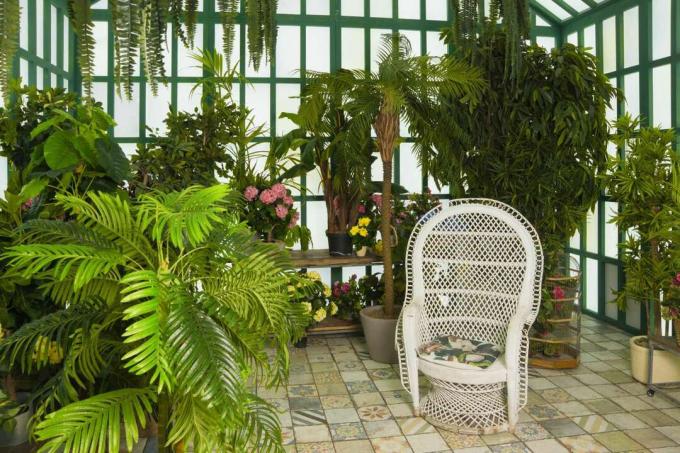
A winter garden is the dream of many gardeners, because it is a place where you can unwind. However, in order for the oasis of well-being to really come into its own, the selection of the right plants is crucial: not every plant will do well in every conservatory. While tropical plants feel particularly comfortable in heated conservatories, other residents prefer a cold winter quarters. You can find out which plant is suitable for which winter garden in our article.
"Contents"
-
Plants for the cold conservatory
- 1. lemon Tree
- 2. star jasmine
- 3. olive tree
- 4. cacti
- 5. camellia
-
Plants for the temperate conservatory
- 1. passion flower
- 2. eucalyptus
- 3. Bottlebrush
- 4. bird of paradise flower
- 5. Palm trees
-
Plants for the warm conservatory
- 1. Bougainvillea
- 2. tomatoes
- 3. orchid
- 4. mango
- 5. clam ginger
Plants for the cold conservatory
Temperatures just below freezing point: The cold conservatory is not for heat-loving plants. In winter, this type of conservatory quickly reaches temperatures of -5 °C because it is not heated and is more related to a weather-protected garden room than to a second living room to compare. Nevertheless, the cold winter garden offers numerous plants a perfect winter quarters: especially those that have a wintry need a break for their growth, but need protection from the weather and need sufficient light, feel right here probably. More like this Potted plants overwintered properly can be found in our special article.
A special form of the cold conservatory is the frost-free conservatory - here, a so-called frost monitor is used for minimal heating so that the temperature never drops below freezing. Plants that are particularly sensitive to frost but need a winter break are suitable for this type of conservatory. In summer, on the other hand, the temperatures in the cold conservatory rise quickly, which is why you should ensure there are sufficient shade or ventilation options.
1. lemon Tree
A lemon tree promises delicious fruit and a touch of summer (Citrus x limon). The Mediterranean plant is not only popular because of its sour fruits, but also because of its pretty appearance: Both its glossy, evergreen leaves as well as its brilliant white, fragrant flowers make the lemon a real one gem. Unfortunately, the lemon tree does not tolerate frost and is therefore only suitable for conservatories with a frost guard, the temperature of which is ideally at least 3 °C. In addition, the lemon should be lightly shaded - it can react to too much light during hibernation with massive loss of leaves.
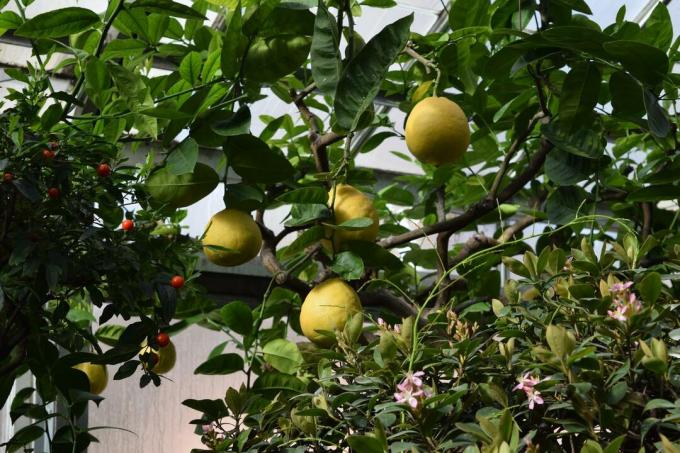
2. star jasmine
Pure white flowers and a heavenly scent - the star jasmine (Trachelospermum jasminoides) is a treat for all the senses. The slow-growing climbing plant is really a great eye-catcher with its flowers, but has the disadvantage that it is hardly found in our country Can hibernate outdoors: The star jasmine can withstand temperatures of -10 °C for a short time, but the plant takes off during longer periods of cold weather Damage. If you still don't want to do without the evergreen beauty, you can keep it in a bucket in the unheated or slightly tempered conservatory, where it is protected from the weather. In summer, the plant can then move back into the garden or stay in the sunny conservatory.

3. olive tree
If you want Mediterranean flair for your winter garden, come on olive tree (Olea europaea) not over: The robust trunk with the distinctive silvery-green leaves is a real eye-catcher and enjoys a large number of lovers - no wonder, after all, the olive tree can also be wonderful here cultivate. While the plant can also thrive in the garden in summer, it should move to the conservatory by fall at the latest. Although the pretty little tree needs a hibernation in order to grow at full strength again next year, it cannot tolerate long-lasting frosts. Ideally the olive tree overwinters in a conservatory with a frost guard, because temperatures just above freezing are ideal for him.
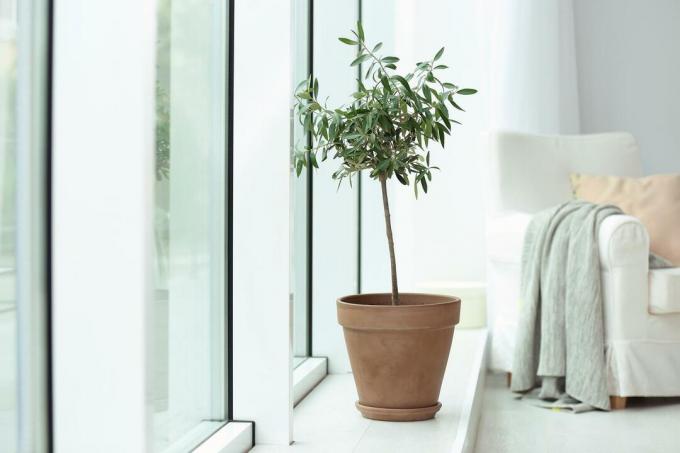
4. cacti
cacti (Cactaceae) are particularly welcome guests with their striking appearance and easy-care nature. But not only as a houseplant, but also in the garden and on the balcony, the plants are enjoying increasing popularity. The only problem here is winter: particularly high levels of precipitation can severely damage plants that are adapted to drought. With cold, on the other hand, many hardy ones come cactus species rightly so, which is why an unheated conservatory is the perfect place for them - thanks to the protection from rain and moisture and that simultaneous high supply of light, the thorny plants get through the winter well and form a real visual one eye-catcher.
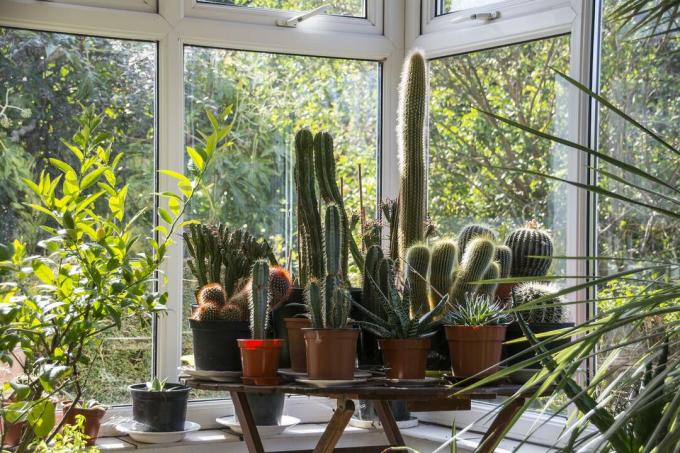
5. camellia
If you don't want to miss out on the splendor of flowers even in winter, you should go to the camellia (Camellia japonica) grab: The exotic beauty is not only known for her enchanting appearance, but has made a name mainly by its unusual flowering period, which runs from January to April runs. In order to display all their splendor in winter, camellias need a place where they will be protected from severe frosts and wind are protected, but the temperature does not rise above 15 °C - this makes the flowers perfect for the frost-free conservatory suitable. If you also make sure that the camellia is placed brightly but not in full sun, you can enjoy its blooms all winter long.
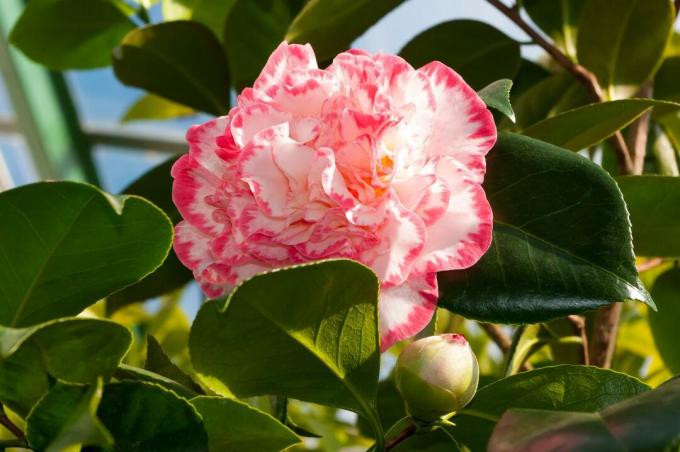
Plants for the temperate conservatory
The temperate conservatory is right in the middle between the cold and warm conservatory – it is heated in winter, but only moderately, so that temperatures range between 5 °C and 15 °C to rule. This means that the temperature-controlled conservatory can only be used as living space to a limited extent, but of all three types of conservatory it offers most plants suitable quarters. Especially exotic plants from South American and African regions, but also most indoor plants feel right at home here. To ensure that not only the temperature is right, but also the amount of light, it is advisable to lay out the temperate conservatory in a southerly direction.
1. passion flower
Hardly any other climbing plant is as eye-catching in the conservatory as this one passion flower (Passiflora caerulea): With its artistically playful flowers in shades of white, red or blue, the plant is an optical sensation that has already found its way into many works of art. Unfortunately, the pretty flower is not frost hardy, which is why it cannot be cultivated in the garden. It is all the more gratifying that the passion flower can be cultivated very well in a temperate conservatory. Equipped with a trellis and in a bright location, the flower will quickly do well. In winter, the passion flower should also take a break at around 10 °C so that it blooms in full splendor again next year.
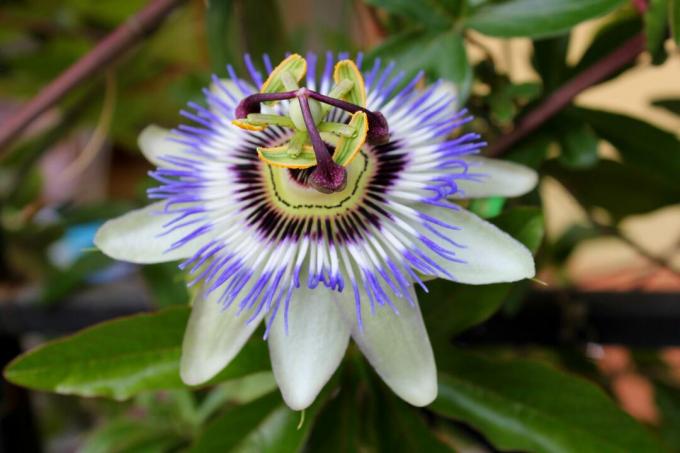
2. eucalyptus
Who doesn't love the intense smell of eucalyptus (Eucalyptus gunnii)? With its unique smell and its decorative bluish to silvery-green leaves, the scented plant an absolute must for every conservatory and can even be used as a medicinal plant be used. In order for the eucalyptus to feel comfortable, however, a few points must be observed: Firstly, it should be in the brightest possible location, as it is particularly sensitive to a lack of light. On the other hand, temperatures of 5 to 10 °C should prevail in winter. If you also give the eucalyptus a little care, it will soon enchant the whole room with its scent.
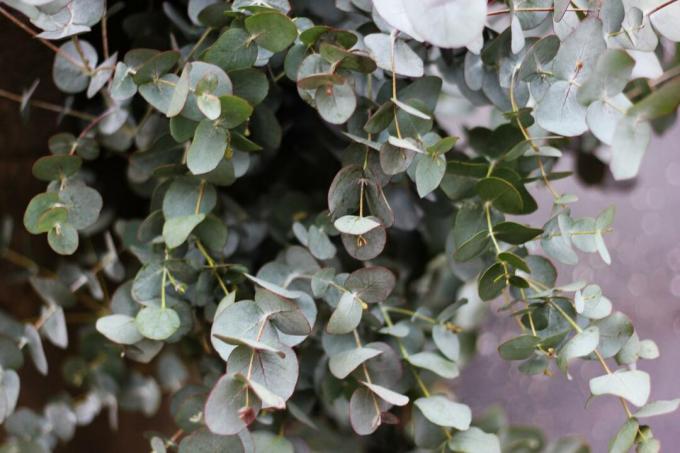
3. Bottlebrush
With its scarlet cylinders of flowers, the Bottlebrush (Callistemon viminalis) a real feast for the eyes - the extravagant plant shows its flowers several times a year. Especially in the temperate conservatory, the colorful shrub attracts envious looks, because here it can be grown all year round. The shrub with the beautiful flowers feels particularly at home in a warm and full sun. The rest phase in winter, on the other hand, can sometimes be a bit colder with temperatures between 5 and 10 °C. Although the bottle brush can also be overwintered warm, the plant is often much more lazy to bloom afterwards.
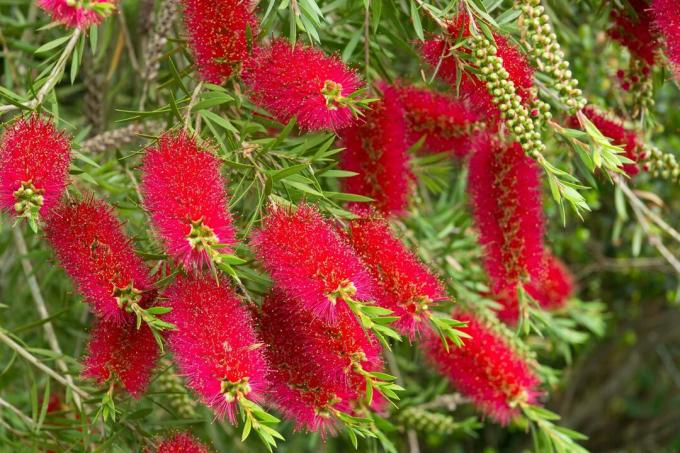
4. bird of paradise flower
The name says it all - hardly any other plant for the conservatory is as extravagant as this one bird of paradise flower (Strelitzia reginae). With its leathery leaves and impressive growth of up to one and a half meters, the pretty plant is a truly majestic sight. But only its fascinating orange flowers make the plant a real eye-catcher. The exotic flower is particularly suitable for the temperate conservatory, because it finds ideal plants here Conditions: A bright and sunny location, where the temperature never falls below 10 °C, is for the Plant optimal. In fact, the mild temperatures in the winter garden, in contrast to the apartment, even have a positive effect on the health of the bird of paradise flower.
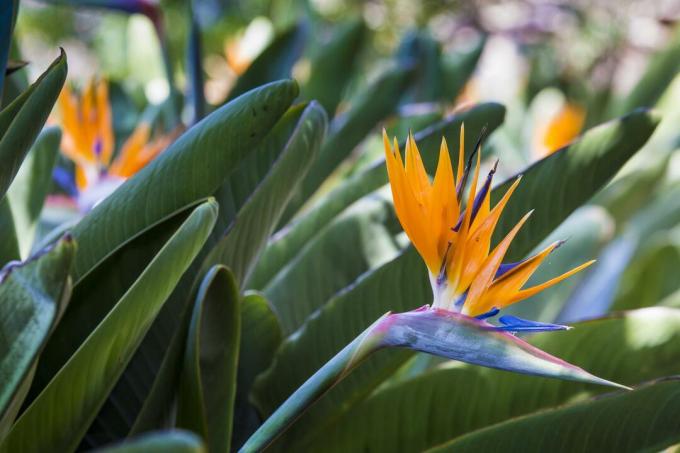
5. Palm trees
Palm trees are probably one of the most popular indoor plants because they create a cozy holiday atmosphere in your own four walls. The magnificent plants grow to their full beauty, especially in the bright conservatory, making them an impressive eye-catcher. The temperate conservatory is perfect for cultivating most types of palm trees, as it allows the plants to rest at around 12 °C in winter. Another advantage of palm trees in the temperate conservatory: there is something for every taste. The Canary Date Palm (Phoenix canariensis) is particularly suitable for beginners, for example, while the ruler palm (Archontophoenix alexandrae) impresses with its coral red fruits. The Chinese umbrella palm (Livistona chinensis) is best known for reaching a stately age, even in conservatories. Even the well-known ones golden fruit palm (Dypsis lutescens) can be wonderfully cultivated in the conservatory.

Plants for the warm conservatory
The heated conservatory can be used all year round and is often used as a living space, which is why it is sometimes referred to as a residential conservatory. Thanks to heating and careful insulation, the temperature in the warm conservatory does not fall below 18 °C even in winter, which is why tropical and subtropical exotic species in particular enjoy this place. But many popular indoor plants also feel right at home in a heated conservatory. Overall, the warm conservatory should have an even temperature of up to a maximum of 23 °C. So that the temperature does not rise too high in summer, it is advisable to lay out the conservatory in a northerly position or to think about additional shading measures.
1. Bougainvillea
Hardly any other plant is able to bring the Mediterranean flair to the conservatory as impressively as this Bougainvillea (Bougainvillea glabra). The climbing plant, also known as triplet, is a real beauty with its purple bracts, which soon attracts everyone's attention. Unfortunately, the bougainvillea is not frost hardy, which is why it is often not even cultivated - in the However, in a heated conservatory, the Mediterranean plant finds perfect conditions of at least 15 °C in front. Growing elegantly on a scaffolding, the bougainvillea soon develops into the secret highlight of the conservatory.

2. tomatoes
Tomatoes (Solanum lycopersicum) many only know from cultivation outdoors or in a greenhouse. But did you know that a winter garden is also suitable for growing tomatoes? In fact, these are perennial plants, which in Germany are often only cultivated as annuals due to the frost in winter. A heated conservatory can help: at temperatures of 22 to 24 °C and in a bright location Healthy tomato plants, especially cherry tomatoes and wild tomatoes, can survive the winter here in Germany survive. However, intensive care is necessary to keep the plants healthy. Alternatively, the heated winter garden can also be used wonderfully for growing new tomatoes - thanks to the warm temperatures and the good lighting conditions, the new seedlings can be grown here much better and earlier than in the garden or on the windowsill.
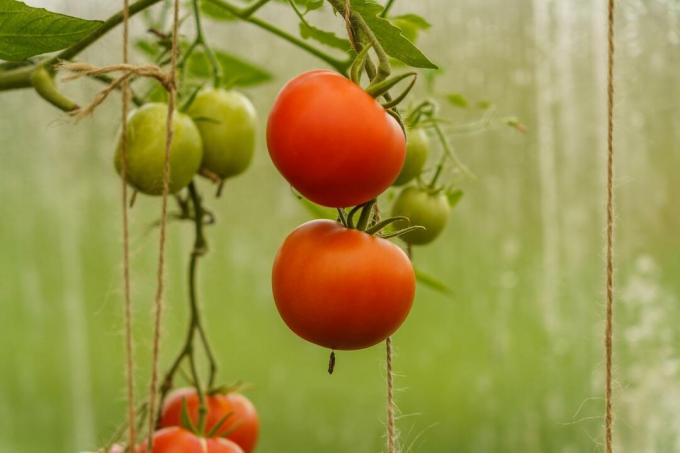
3. orchid
Hardly any other flowering houseplant is as popular as this one orchid (Orchidaceae). One of the plants with the delicate flowers can be found in almost every household, although the orchid is considered to be particularly demanding in terms of care. But the exotic beauties not only cut a fine figure as a houseplant - they can also be cultivated very well in the conservatory. In particular, the bright but not too sunny location and the warm temperatures benefit the discreet houseplants and ensure that they show their full beauty.

4. mango
The sweet and juicy fruits of the mango (Mangifera indica) are probably found in most kitchens. To the Planting your own mango tree However, many do not dare to approach it, as it usually does not get along with the German weather. A heated conservatory can help: At temperatures above 15 °C, the mango feels extremely comfortable and is a real asset as a potted plant. So that the mango also bears juicy fruit in the winter garden, it is important to open the windows in summer, as soon as the beautiful mango blossoms appear - this is the only way insects can pollinate the plant care for.
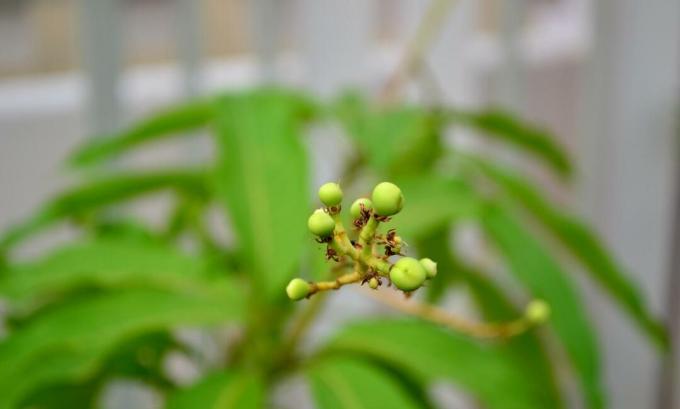
5. clam ginger
A real rarity among ornamental plants is the mussel ginger (Alpinia Zerumbet) - in fact, the exotic is hardly to be found in Germany - wrongly, in our opinion, after all it is the mussel ginger a real beauty: With its upright, slender growth and its decorative leaves, the plant is an asset to everyone Space. A special eye-catcher are the pink-tinged, round-oval flowers of the mussel ginger, which hang in dense clusters on the plant and have an interesting yellow-red marking inside exhibit. The mussel ginger can be wonderfully cultivated in a heated winter garden, because it is valid to be extremely hardy and adaptable as long as it is kept at a minimum temperature of 12°C will.

tip: Potted plants need nutrients regularly, as these are quickly used up in the limited pot volume. The easiest way is to use a liquid fertilizer over the irrigation water. We therefore recommend ours for citrus and Mediterranean plants that are popular in conservatories Organic citrus & Mediterranean fertilizer.
